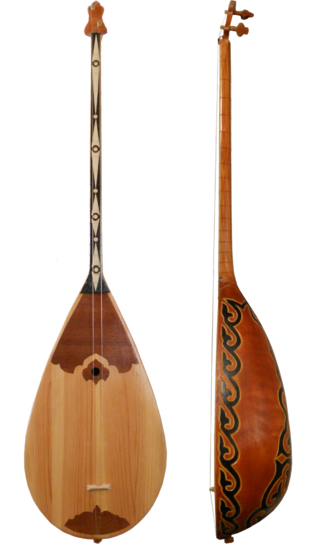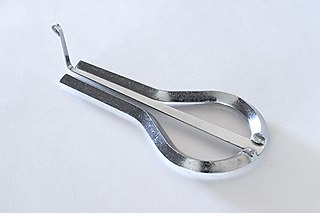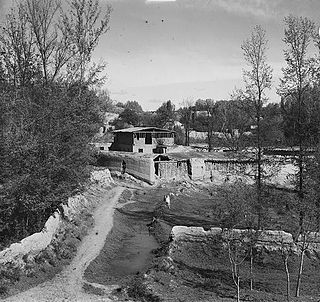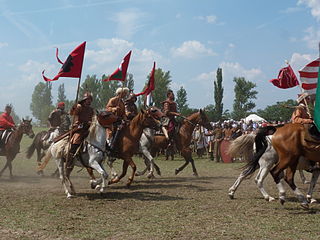
The Dombra, also known as Dombyra or Tambura is a long-necked musical string instrument used by the Kazakhs, Uzbeks, Turkmens, Hazaras, Bashkirs and Nogais in their traditional folk music. The Dombura shares certain characteristics with the komuz and dutar instruments, such as its long, thin neck and oblong body shape. It is a popular instrument mostly among Turkic and Iranic communities in Central Asian countries such as Kazakhstan, Uzbekistan, Tajikistan, Turkmenistan and Afghanistan.
Kyrgyz music is nomadic and rural, and is closely related to Turkmen and Kazakh folk forms. Kyrgyz folk music is characterized by the use of long, sustained pitches, with Russian elements also prominent.
Music of Kazakhstan refers to a wide range of musical styles and genres deriving from Kazakhstan. Kazakhstan is home to the Kazakh State Kurmangazy Orchestra of Folk Instruments, the Kazakh State Philharmonic Orchestra, the Kazakh National Opera and the Kazakh State Chamber Orchestra. The folk instrument orchestra was named after Kurmangazy Sagyrbayuly, a well-known composer and dombra player from the 19th century.

The Jew's harp, also known as jaw harp, juice harp, or mouth harp, is a lamellophone instrument, consisting of a flexible metal or bamboo tongue or reed attached to a frame. Despite the colloquial name the Jew's harp most likely originated in Siberia, specifically in or around the Altai Mountains, and has no relation to the Jewish people.

The komuz or qomuz is an ancient fretless string instrument used in Central Asian music, related to certain other Turkic string instruments, the Mongolian tovshuur, and the lute. The instrument can be found in Turkic ethnic groups, from China to Turkey. Forms of this instrument are used in China by the Naxi people and are called Huobusi, Hebisi , and Hunbusi.
Tuva is a part of Russia, inhabited by a Turkic people. Tuvans are known abroad for khoomei (xöömej), a kind of overtone singing.
The music of Central Asia is as vast and unique as the many cultures and peoples who inhabit the region. Principal instrument types are two- or three-stringed lutes, the necks either fretted or fretless; fiddles made of horsehair; flutes, mostly sige at both ends and either end-blown or side-blown; and jew harps, mostly metal. Percussion instruments include frame drums, tambourines, and kettledrums. Instrumental polyphony is achieved primarily by lutes and fiddles.

The letter Ƣ has been used in the Latin orthographies of various, mostly Turkic languages, such as Azeri or the Jaꞑalif orthography for Tatar. It is also included in pinyin alphabets for Kazakh and Uyghur; and in the 1928 Soviet Kurdish Latin alphabet. It usually represents a voiced velar fricative but is sometimes used for a voiced uvular fricative. All orthographies that used the letter have been phased out and so it is not well-supported in fonts. It can still be seen in pre-1983 books published in the People’s Republic of China.
Od iyesi is the Turkic and Mongolian spirit or deity of fire. In Turkic languages, Od means fire, and iye is the familiar spirit of any natural asset, literally meaning "master" or "possessor." Od iyesi protects the fire.

The kobyz or kylkobyz, or qobyz, is an ancient Turkic bowed string instrument, spread among Kazakhs, Karakalpaks, Bashkirs, and Tatars. The Kyrgyz variant is called the kyl-kyyak).

Kishlak or qishlaq, or qıştaqqıstaw is a rural settlement of semi-nomadic Turkic peoples of Central Asia and Azerbaijan. The meaning of the term is "wintering place" in Turkic languages.

The chang is a Persian musical instrument, a vertical angular harp. It was very popular and used widely during the times of ancient Persia, especially during the Sasanian Dynasty where it was often played in the shahs' court. It was also played until the 19th century in the Ottoman Empire but has since disappeared from Turkish folk music.
The wooden jaw harp or shangqobyz is a type of jaw harp made out of wood, common in the folk music of Turkic peoples in Central Asia. The principals used to produce notes are similar to those for a metal jaw harp, but wooden jaw harps are often much larger in size, resembling a simple bow.

The Great Kurultáj or briefly Kurultáj is a traditional event of peoples of Central Asian nomadic origins, which takes place in the first week of August in Bugac, Hungary. The aim of this event is to strengthen the unity of the Eurasian steppe-nomadic horse culture and traditions between Hungarians and their cultural relatives, eastern Turkic peoples and Altaic peoples. The first Kurultáj was held in the Torgay Region of Kazakhstan in 2007. The first Kurultáj in Hungary was held in 2008. These events contributed much to the revival of the Altaic self-awareness.
In Turkic mythology, Su Iyesi is a water spirit. It corresponds to the nymph in Turkic cultures. It is a disembodied, incorporeal, intangible entity, but she can turn into a female creature and daughter of Yer Tanrı. Sometimes the master of water is depicted in the form of a bull.

Ayaz Ata is a winter god in Tengriism and a fictional tale character that it represents who in some Turkic cultures plays a role similar to that of Santa Claus or Ded Moroz. The literal translation of the name would be "Frost Father", although the name is often translated as "Grandfather Frost". He was created of Moon light and caused by cold weather.
Yel iyesi is the Turkic spirit or deity of wind. The name comes from the Turkic words "Yel," which means wind, and "iye," the familiar spirit of any natural asset.
Szélatya or Szélkirály is the Hungarian god or deity of wind.










